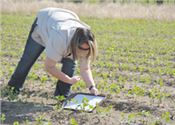|
Seed Treatments Lose Punch Against Thrips
INDIANOLA, MISS.
Seed treatments have minimized thrips damage for the last decade, but farmers and entomologists fear some pesticides may be losing their punch in protecting cotton.
Scientists at Mississippi State University and other universities across the Midsouth have been aggressively exploring options for controlling thrips damage in cotton.
Angus Catchot, an entomologist with the MSU Extension Service, said the use of foliar treatments for thrips in cotton has grown steadily in recent years.
“Even with seed treatments, farmers have always had to apply some foliar sprays on a low percentage of the acres, but we have noticed an increase in needs for foliar applications and in the amount of damage from thrips,” Catchot said.
“We have considered other potential reasons, including pre-emergence herbicides, that might be slowing cotton’s growth and keeping it at a more vulnerable stage longer,” he said. “While there may be several contributing factors, the primary reason for increased damage from thrips is the development of resistance to one of the neonicotinoid insecticides, the primary class of insecticides used in seed treatments.”
Only the tobacco thrips have developed resistance, Catchot said, but that species accounts for more than 90 percent of the thrips infesting this region’s cotton. Thrips can delay cotton maturity and reduce yield if not controlled. Currently, seed treatments are the primary methods for control.
To study the resistance problem, Catchot teamed with associate professor Fred Musser and graduate students in the MSU Department of Biochemistry, Molecular Biology, Entomology and Plant Pathology.
“We have studied pesticide resistance in other insects, but we did not think it would become a problem in thrips,” Musser said. “They have many plant hosts and are only in cotton for one generation, unlike tarnished plant bugs that have three or four generations in cotton.”
Musser, a researcher with the Mississippi Agricultural and Forestry Experiment Station, said he believes resistance develops because the thrips are in other crops that rely on the same seed treatments. Yield losses in those crops may not even be noticeable.
“The thrips are getting significant exposure to the seed treatment pesticides before arriving in cotton,” he said. “The resistance is not from one year of exposure but is cumulative for the last 10 years or so, year after year and many generations.”
The researchers are working with some of the companies that develop the seed treatments and other land-grant universities in the Midsouth to determine the best course of action.
Chelsie Darnell, a graduate student in entomology, is spearheading the field work for the research project. She and other graduate students are collecting thrips, primarily from seedling crops.
“We have been collecting thrips from agricultural regions across the state, as well as testing samples collected in Tennessee and Arkansas,” Darnell said. “Some were on wild host plants, and others were in a variety of young crops.”
Workers gently beat plants against a white collection tray. Using a straw-sized hose, they suck the thrips into a small tube and cap each vial when it contains about 50 thrips.
“We take them to the lab and keep them alive on cabbage until we test them for resistance to the neonicotinoid class of insecticides,” Darnell said.
Even if companies shift from one pesticide to another, Musser said he anticipates that thrips will develop resistance again eventually as long as the industry uses the same pesticide in all crops.
“Before seed treatments, farmers used an in-furrow pesticide, a practice that was mostly discontinued as seed treatments were effective, and easier and safer to use,” he said. “The only options now available if seed treatments are not sufficient are foliar sprays, which are time-consuming to apply, difficult to apply before damage occurs, and can kill beneficial insects.
“Foliar insecticides are not a long-term solution to thrips control, but they may provide a short-term strategy until more resistant cotton varieties or a new technology can be developed to manage this troublesome pest,” Musser concluded. ∆

Mississippi State University graduate student Chelsie Darnell of Union City, Tennessee, gently knocks thrips from soybean plants to her collection tray in a Sunflower County, Mississippi, field on June 3, 2015.
Photos by MSU Ag Communications/Linda Breazeale

Mississippi State University worker Brad Tubbs of Grenada examines the thrips he has collected from soybean plants in a Sunflower County, Mississippi, field on June 3, 2015.
|
|